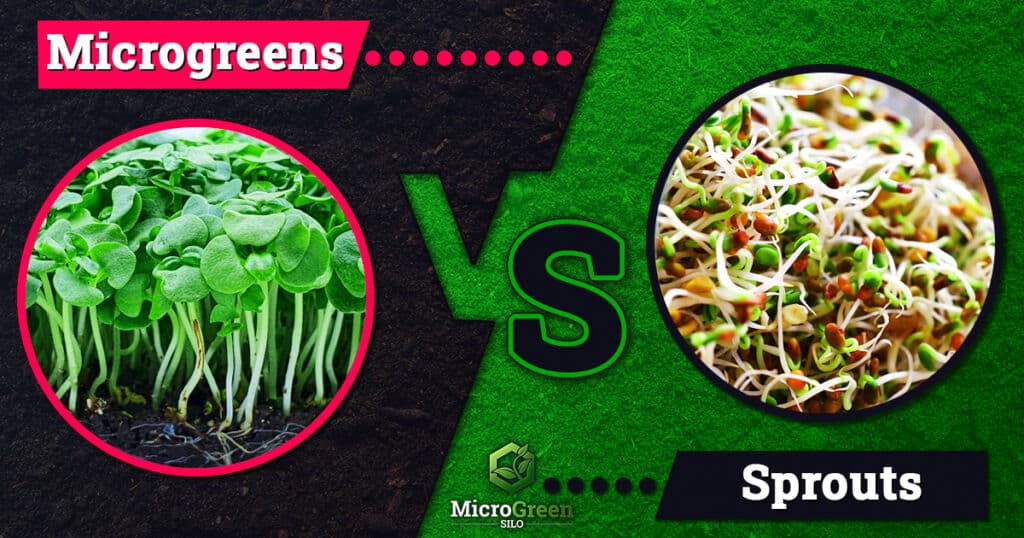
I often get asked “Are microgreens the same as sprouts ?” the simple answer is no, they’re not. Let’s explore the differences between microgreens vs sprouts in detail.
Microgreens and sprouts have noticeable differences in their cultivation methods, growth time, flavor, texture, and nutritional value. Microgreens are small vegetables or herbs harvested just before their first true leaves emerge, resulting in rich flavors and diverse textures. Sprouts are seeds germinated only in water, providing a delicate flavor and a satisfying crunch.
Understanding the difference between microgreens and sprouts allows you to make informed decisions when including these colorful greens in your meals.
Whether you want a rush of complex flavors and textures from microgreens or a delicate, crisp bite from sprouts, understanding the distinctions allows you to personalize your culinary experiences to your preferences and dietary needs.
In this comprehensive comparison, we’ll cover the similarities and differences between microgreens and sprouts, understand the cultivation process, and finally, delve into their nutritional content. Let’s go!
Introduction
From gourmet restaurants to home kitchens, microgreens & sprouts are becoming must-have ingredients for many culinary lovers.
Despite their small appearance, these tiny plants deliver a powerful punch of vibrant tastes, textures, and health benefits.
Yet many people still don’t understand the difference between microgreens and sprouts.
While they might seem similar at first glance due to their small size and green color, understanding the differences between microgreens and sprouts is critical for several reasons.
From a culinary perspective, while both provide unique tastes and textures that can enhance a dish’s flavor profile, they also have distinct individual characteristics that contribute different elements to meals.
Nutritionally, they differ considerably; though both are nutritious, some essential vitamins or minerals may be found more abundantly in one than the other.
Also, there is a big difference in how microgreens and sprouts are grown, each requiring specific conditions for optimal growth, which affects flavor, texture, and nutrition.
Let’s examine the similarities and differences between microgreens and sprouts, how they’re grown, flavors, textures, and nutritional values.
You’ll have a solid understanding of microgreens and sprouts by the end of this post, which will broaden your knowledge of microgreens and sprouts and improve your home gardening game.
Understanding Microgreens & Sprouts
Microgreens are tiny plants, essentially youthful vegetables or herbs.
They are not a specific kind of plant but rather a term denoting the immature growth phase, typically between 2-7 inches (5.08-17.78cm) tall.
Generally harvested within 5-25 days after germination (depending on type), when the cotyledon leaves have fully developed, they lie somewhere between sprouts and baby greens in terms of their maturity.
However, sprouts are germinated seed shoots of a plant.
They are typically grown hydroponically in water in high relative humidity and harvested while their cotyledons are still under-developed and true leaves have not begun to emerge, usually within 3-5 days after germination.
Here’s a table comparing all the differences between microgreens and sprouts.
variables |
microgreens |
sprouts |
|---|---|---|
| Time To Harvest | 5-25 Days Depending on variety | 3-5 Days Depending on variety |
| Vegetable Length | 2-7 Inches (5.08-17.78cm) | 1-2 Inches (2.54-5.08cm) |
| Growth Medium | Soil, Coconut Coir, Peat Moss, Vermiculite, Perlite, Rockwool, Hydroponic Mats, Coco Mats, Bamboo Fiber Mats, Paper Towels, Hemp Mats, Jute Mats, Hydroponically | Hydroponically, usually in a mason jar with a cheesecloth or mesh lid |
| Physiological Appearance | Bigger than sprouts. Seeds produce a shoot with cotyledons, grown until the true leaves appear | Smaller than microgreens. Seeds produce roots and a shoot with cotyledons only |
| Consumption | Microgreen stems and leaves are consumed, and everything below the soil line is discarded or composted | Sprouts are consumed in entirety, roots, stem, and cotyledons, just don’t drink the water! |
| Nutritional Values | Higher than sprouts | Less than microgreens |
| Light Requirements | Microgreens require light exposure | Sprouts don’t require light exposure |
| Ventilation Requirements | Microgreens require good ventilation to prevent fungi and mold | Sprouts don’t require ventilation, but do require constant rinsing |
| Varieties | Over 100 different varieties and cultivars can be grown as microgreens | 15-20 varieties can be sprouted |
| Harvest Methods | Sharp knife or scissors | Remove them from the sprouting jar, rinse and consume |
| Food Safety | Microgreens are less prone to foodborne illnesses because they are grown in soil or other growing mediums, minimizing their exposure to potential contaminants. | Sprouts are more prone to foodborne illnesses due to their warm and humid growing environment, which can encourage the growth of harmful bacteria. |
Definition and Characteristics
Microgreens and sprouts may seem similar, but they actually have distinct characteristics, growth stages, harvest times, flavors, and textures.
Let’s explore the differences and identify the key factors differentiating microgreens from sprouts.
Defining Microgreens and Sprouts
Microgreens Definition
Microgreens are seedlings of vegetables and herbs that have formed cotyledons (embryo leaves) that are harvested before or shortly after the first true leaves emerge.
Flavors range from earthy and spicy to sweet and tangy. These wicked flavors improve salads, sandwiches, and many other meals.
They feature vibrant hues and a more concentrated nutritional value than their fully mature counterparts.


Sprouts Definition
However, sprouts are seeds cultivated in a hydroponic environment until germination occurs. When the roots and stems emerge, they are ready for harvest.
This rapid growth phase, spanning just a few days, yields crunchy textures and delicate flavors, making sprouts a popular choice for various dishes. Commonly found in sandwiches, wraps, and salads. They bring a delightful crunch and a hint of nuttiness to meals.


Are Sprouting Seeds and Microgreen Seeds The Same?
Often, people wonder if sprouting seeds and microgreen seeds are the same. The answer to this question is yes, they are!
Here is the deal. While both start from the same seeds, they take different growth paths. Sprouts are grown for a shorter period, while microgreens are grown longer.
Sprouting seeds are great for fast cultivation and will give you fresh and crunchy sprouts in just a few days.
On the other hand, microgreen seeds are grown for a longer period and develop into small, colorful plants that are rich in both taste and nutrients.
Microgreen and sprouting seeds are simply seeds grown using a specific method and do not have any biological significance. Certain species of plants, like tomatoes, are not classified as microgreen or sprouting seeds because their plant structure is inedible.
But here is the kicker: same seeds, different roles, that is it!
Growth Stages and Harvesting Times
Let’s dive into the growth stages and harvesting times – it’s not as complex as it might sound!
Sprouts are extremely easy to grow. They have an incredibly short growth period of 3-5 days.
Sprouts are grown until the young shoots and roots emerge, usually between 3-5 days, depending on the sprout variety being grown.
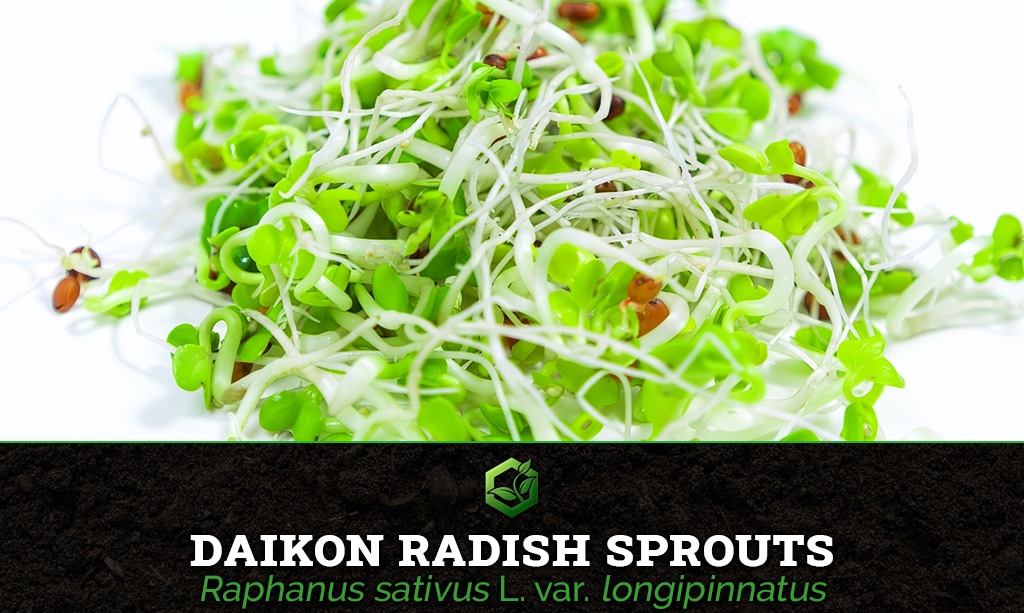
Here’s a table of popular sprout types and when they’re ready for harvest.
Sprout Type |
When to Harvest |
|---|---|
| Broccoli Sprouts | 3-5 days |
| Alfalfa Sprouts | 3-5 days |
| Mung Bean Sprouts | 3-5 days |
| Red Clover Sprouts | 4-6 days |
| Radish Sprouts | 3-5 days |
| Green Pea Sprouts | 3-4 days |
| Fenugreek Sprouts | 4-5 days |
| Garbanzo Bean Sprouts | 2-3 days |
| Wheat Sprouts | 2-3 days |
| Lentil Sprouts | 2-4 days |
Harvesting your sprouts is even simpler! Remove them from the mason jar by hand, rinse them well under cool running water, drain, and enjoy!
Microgreens, however, need more time to grow until they are ready for harvest. The quickest-growing plant is the radish (Raphanus sativus). Radishes take 5-7 days to cultivate!
Microgreens are grown until the embryo leaves (cotyledons) form and the first true leaves appear. Some people enjoy the texture and flavor of microgreens before the true leaves form. It is entirely a matter of personal preference.
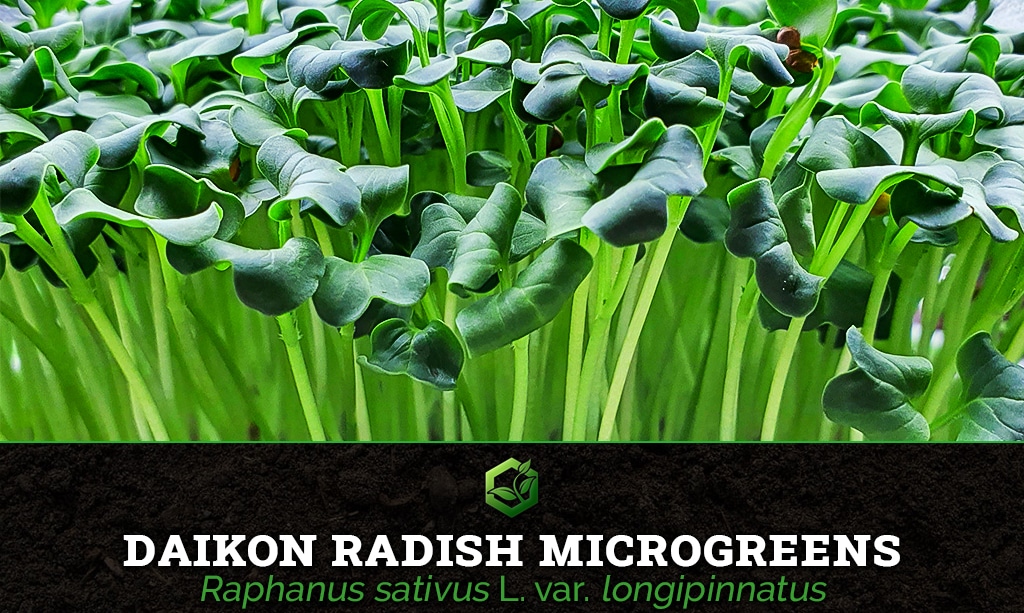
Here’s a table of popular microgreens and when they’re ready for harvest.
Microgreen Type |
When to Harvest |
|---|---|
| Arugula Microgreens | 5-8 days |
| Basil Microgreens | 20-25 days |
| Beet Microgreens | 10-21 days |
| Cilantro Microgreens | 14-21 days |
| Mustard Microgreens | 6-12 days |
| Radish Microgreens | 5-7 days |
| Sunflower Microgreens | 7-10 days |
| Swiss Chard Microgreens | 10-21 days |
| Pea Microgreens | 8-16 days |
| Kale Microgreens | 7-12days |
Microgreens require more effort to harvest than sprouts. It’s still simple; all that’s needed is a sharp tool, such as a sharp knife or scissors.
Personally, I love using the Green Mercer Produce Knife—I highly recommend it!
But if you prefer scissors, you can use them just make sure they’re sharp!
Using your preferred cutting tool, you cut the microgreens just above the soil line, avoiding contact with the soil to prevent contamination.
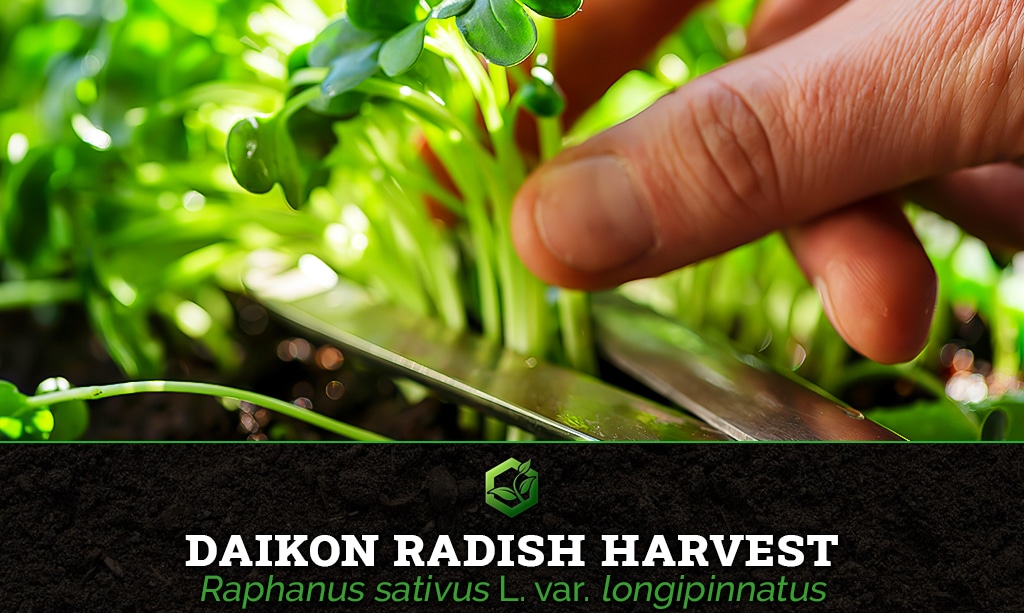
It’s important to note that sprouts have a much shorter harvest time compared to microgreens.
While sprouts typically reach maturity in just 3 to 5 days, microgreens require more time depending on the type grown, anywhere from 5 to 25 days to mature and become ready for consumption.
When we take into account those averages, microgreens take approximately 78% more time to grow than sprouts! Here’s a diagram showing the difference in harvest time for microgreens vs sprouts.
Microgreens vs Sprouts: Flavor Profiles and Textures
While the terms microgreens and sprouts are frequently used interchangeably in the culinary world, they offer diverse flavor profiles and textures that can alter the taste and feel of a dish. Let’s dive in and discuss microgreens vs. sprouts’ flavor and texture profiles.
Microgreen Flavors & Texture Profiles
Microgreen flavors range from mild, strong, earthy, spicy, tangy, tart and sweet, depending on the type of plant grown.
For example, arugula microgreens have a peppery punch, basil microgreens offer a full-bodied basil flavor with a hint of sweetness, while radish microgreens give a spicy pungent kick.
Microgreens have a tender, crunchy, juicy, and delicate texture, making them ideal for garnishing meals without overpowering the other ingredients.
Their delicate yet beautiful appearance gives a sense of sophistication to meals.
Sprout Flavors & Texture Profiles
The flavor profile of sprouts is often milder than microgreens but depends on the type of seed sprouted.
For example, mung bean sprouts have a crispy, nutty flavor and texture. Alfalfa sprouts have a mild, nutty, and mildly sweet flavor. In contrast, broccoli sprouts can have a more pronounced, peppery punch similar to radish.
Sprouts are known for their crunchy texture, as the whole seed, shoot, and roots are edible. They make a great addition to salads, sandwiches, and wraps, providing a fresh and tasty flavor.
Both microgreens and sprouts offer unique qualities to dishes with varying levels of flavor and texture. Microgreens deliver concentrated and bold flavors with crunchy and juicy texture undertones. On the other hand, sprouts have a milder flavor with a satisfying crunch.
Whichever option you favor, it comes down to personal preference.
Microgreens vs Sprouts Cultivation
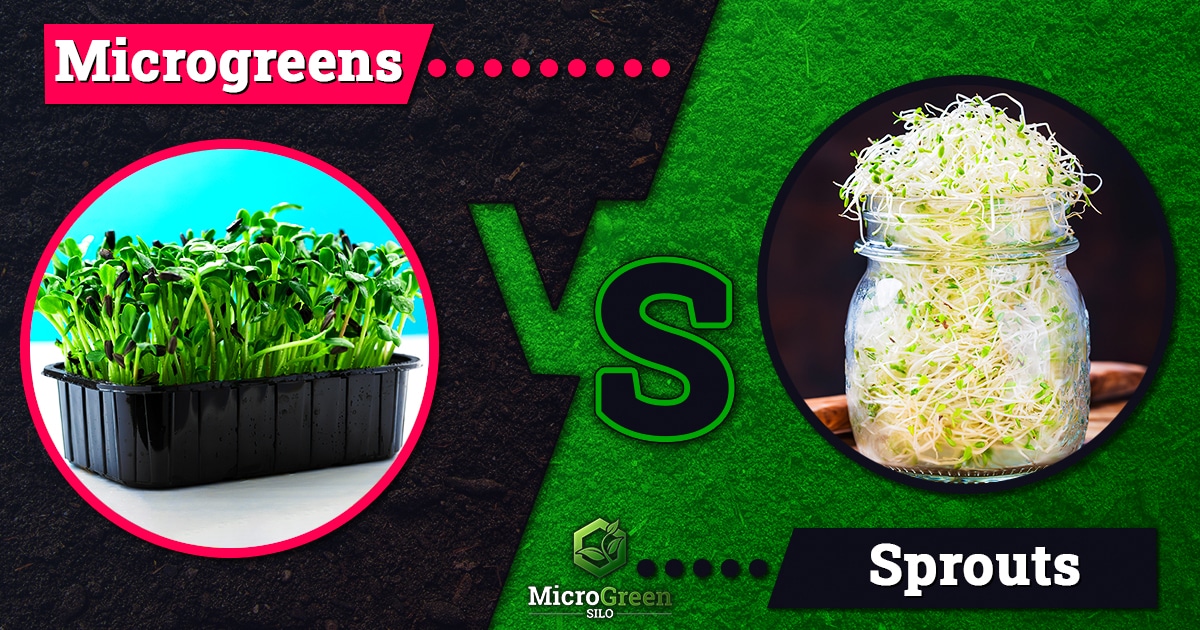
Sprout and microgreen cultivation is simpler than you might think! But they differ significantly.
Dive into this section as we shed light on the basics of growing microgreens and sprouts.
Covering every growth detail is beyond the scope of this post.
For those keen on mastering a particular microgreen variety, our comprehensive microgreen growing guides await you here.
Cultivating Microgreens
Growing microgreens can be easy once you learn how. Here are the basic steps to grow microgreens!
- Choosing Seeds: Start by selecting certified organic microgreen seeds. Popular choices include radish, arugula, and sunflower.
- Preparation: Grab a shallow tray and fill it with a quality potting mix. Ensure it’s moist but not soggy.
- Sowing: Sprinkle the seeds evenly across the soil. No need to bury them with soil; a light press with your hands or an empty tray will do.
- Cover & Wait: Cover the tray with a lid or another tray. This creates a mini greenhouse effect. In a few days, you’ll see sprouts!
- Expose To Light: Once sprouted, expose them to sunlight or a grow light. I’ve found that providing them with 17 hours of light followed by a 7 hour break works well for me.
- Watering: Mist them gently. They prefer staying moist but not drenched.
- Harvest Time: In 5-25 days, depending on the variety, your microgreens are ready. Snip them with scissors or a knife and enjoy!
Cultivating Sprouts
Sprouts are much easier and cheaper to cultivate compared to microgreens. Let’s cover their cultivation method so you can enjoy fresh sprouts in a fraction of the time!
- Selecting Seeds: Begin with quality certified organic sprouting seeds. Favorites include alfalfa, mung beans, and broccoli.
- Rinse & Soak: Place seeds in a jar and cover with water. Let them soak overnight.
- Draining: The following day, use a mesh lid or cheesecloth to drain all the water and ensure no water remains.
- Rinse & Repeat: Twice a day, rinse the seeds with fresh water and drain. It keeps them hydrated and prevents mold.
- Darkness to Light: Keep the jar in a dark location for the first few days. Once the sprouts emerge, you can move them to a spot with indirect light, which will help them turn green.
- Watch Them Grow: In 3-5 days, depending on the seed type, your sprouts will be ready!
- Harvest & Enjoy: Rinse them one final time, remove any un-sprouted seeds, and enjoy!
Containers, Soil, and Growing Mediums
The decisions you make while beginning your cultivation journey can significantly influence your experience. Each choice, from trays to the soil and mediums, can make a significant difference. Let’s go over the specifics:
Containers
When cultivating microgreens or sprouts, the correct container is critical.
Shallow trays with drainage holes are ideal for microgreens. They provide ample space for growth and ensure that any excess water has an escape route.
These green trays are perfect for home use or small-scale farming. I use them in my home grow room for year-round microgreens.
No products found.
On the other hand, when I’m sprouting, I use mason jars with mesh tops. They’re perfect for good airflow and make the regular rinsing process a breeze.
No products found.
Soil for Microgreens
Soil is critical to the success of your microgreens. In my experience, using an organic, nutrient-rich potting mix works well and keeps everything balanced. To help the roots grow strong and keep the soil moist, you can add things like coconut coir, vermiculite, or perlite. It keeps it aerated and is necessary for the microgreens to thrive.
Growing Medium for Sprouts
Sprouts don’t require soil; they thrive just with water. But here’s a golden nugget of advice: focus on drainage. It’s paramount. Ensuring the water doesn’t stagnate will keep your sprouts healthy, vibrant, and mold-free.
Lighting and Watering Requirements
When cultivating microgreens and sprouts, achieving the right balance of light and water is crucial for growth. Let’s explore this delicate process.
Microgreens
- Light: A sunny windowsill with 4-6 hours of sunlight is perfect for microgreens. Indoors, fluorescent or LED grow lights are a must. Place them 4-6 inches above for optimal exposure.
- Water: A spray bottle is a helpful tool for watering delicate microgreens. It distributes moisture evenly and minimizes mold risks. After the seeds have germinated, water them from the bottom to reduce the chances of mold growth.
Sprouts
- Light: Sprouts only need light exposure on the last day to turn green.
- Water: A twice-daily rinse and thorough drainage regimen keep them hydrated and healthy.
Microgreens vs Sprouts Nutrition
Nutritional Comparison: Microgreens vs Sprouts
Microgreens and sprouts have different nutrient content, but both offer nutritional benefits. Let’s explore them in detail.
Because microgreens are more developed than sprouts, they have higher levels of nutrients such as vitamins, minerals, and antioxidants, which can influence overall health.
Microgreens like kale and broccoli are rich in vitamins C and K, as well as carotenoids, which are powerful antioxidants that fight oxidative stress in the body.
In contrast, sprouts like alfalfa or clover focus more on providing proteins and dietary fibers, particularly vitamin B complex, which is essential for energy production and red blood cell formation.
It’s important to note that both microgreens and sprouts offer unique health benefits despite their nutritional differences.
Low in calories but high in nutrients, they can be incorporated into various diets without contributing excessively to calorie intake.
While microgreens may have a slight nutritional advantage, sprouts are still valuable for those seeking plant-based proteins or aiming for a high-fiber dietary intake.
Both microgreens and sprouts are essential components of a balanced diet, providing unique benefits and contributing to better health and well-being.
Health Benefits of Consuming Microgreens and Sprouts
Adding microgreens and sprouts to your meals not only adds color and crunch but also provides a wealth of health benefits.
These small plant foods are packed with vitamins, minerals, and antioxidants that can improve your health in several ways.
Research shows that microgreens contain higher levels of nutrients than their mature counterparts.
For example, red cabbage microgreens have a lutein/zeaxanthin concentration of 8.6 mg/100 g fresh weight (FW).
Amaranth Red Garnet microgreens are rich in lysine and have higher nutritional densities compared to their mature leaves, an essential amino acid often lacking in grains.
Sprouts also have their share of health benefits. The process of sprouting increases the bioavailability of nutrients like vitamins B and C, folate, fiber, and essential amino acids while decreasing antinutrients like phytic acid, which can interfere with mineral absorption.
Broccoli sprouts are particularly notable for their cancer-fighting properties due to their high levels of sulforaphane.
Incorporating microgreens and sprouts into your meals is a simple way to enhance both taste and nutritional content.
Growing microgreens and sprouts is easy and requires minimal space and time, making it feasible even for those living in urban environments with limited outdoor facilities.
It’s important to remember that consuming a variety of plant foods is essential to good health, so it’s best to include both microgreens and sprouts along with other fruits and vegetables in your diet.
Always make sure to source them from reliable sources or grow them under sanitary conditions to avoid foodborne illnesses.
Culinary Uses
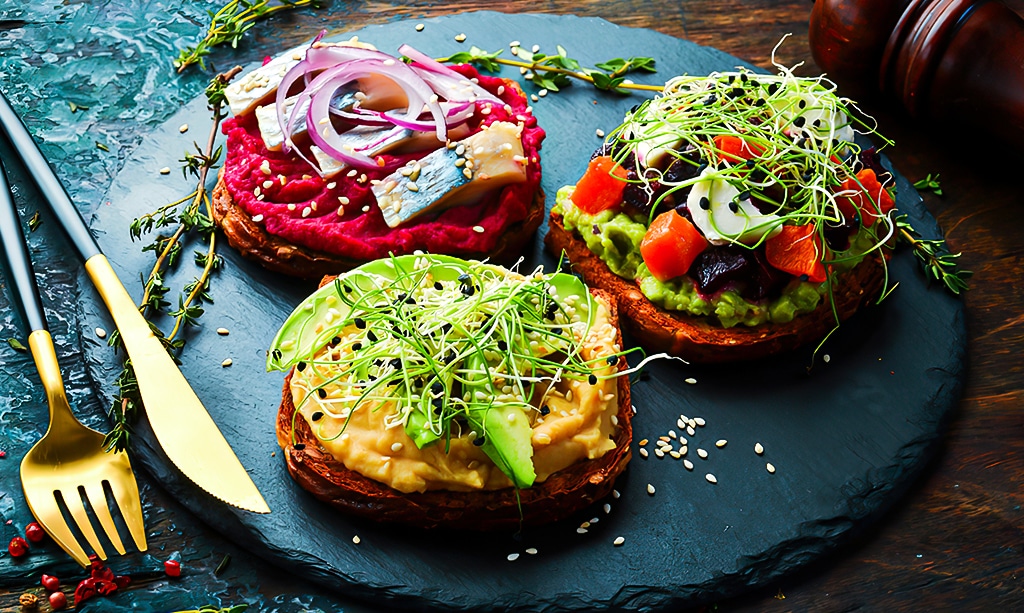
Utilizing Microgreens and Sprouts in Dishes
Chefs have discovered the benefits of using microgreens and sprouts in their dishes.
Not only do they add vibrant colors and crunchy textures, but they also bring significant nutritional value to the plate.
These small plants are versatile and can be incorporated into a variety of culinary creations, ranging from simple salads to complex main courses.
Their diverse flavors, ranging from sweet to spicy, can enhance any dish.
Microgreens have tender leaves and delicate stems that make excellent garnishes for soups, sandwiches, and salads.
Radish microgreens, for example, add a spicy kick that pairs well with creamy soups or avocado toast.
They also complement seafood dishes like salmon or tuna tartare, providing a fresh burst of flavor and crunch.
In addition to their gastronomic appeal, microgreens are packed with vitamins and antioxidants, making them a nutritious addition to any meal.
Sprouts, which have traditionally been used in East-Asian cuisine, have gained global popularity due to their unique taste profile and health-promoting properties.
They can be stir-fried with other vegetables for a quick side dish that is high in protein and fiber, blended into smoothies for an extra dose of enzymes, or tossed raw into salads for added texture.
Mung bean sprouts are particularly popular in Korean cuisine and are used in traditional dishes like bibimbap, which is known worldwide.
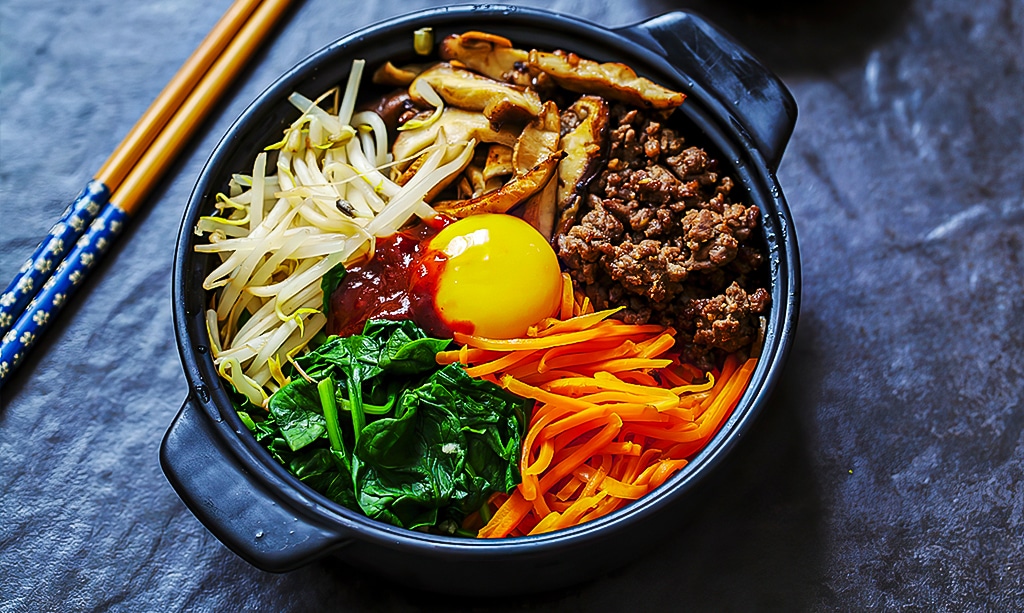
Even desserts can benefit from these nutrient-dense greens. Microgreen varieties like lemon balm and chocolate mint are exceptional options to elevate the taste and visual appeal of desserts like ice cream and sorbets.
In conclusion, microgreens and sprouts prove that size does not always matter. Despite their small size, they can enhance the visual appeal and nutritional value of everyday dishes and gourmet creations.
Popular Varieties
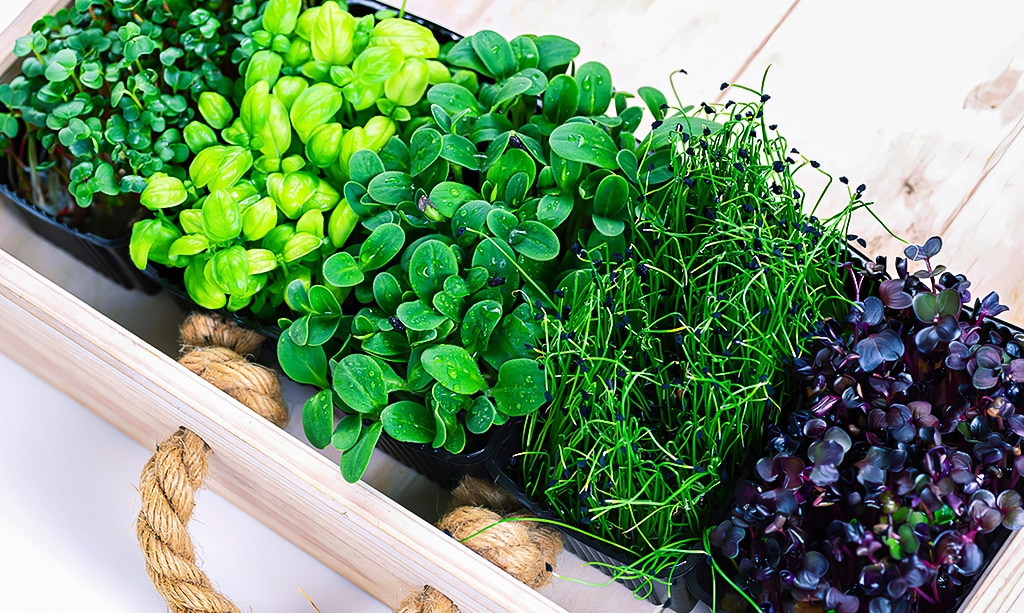
Popular Varieties of Microgreens
As you explore the world of microgreens, you’ll discover a wealth of delicious and nutritious options.
- One of the most beloved varieties is sunflower microgreens. These little shoots have a slightly nutty taste and a satisfying crunch, making them ideal for salads or as a garnish for heartier dishes. They’re rich in essential nutrients like Vitamins A, B complex, D, and E, along with calcium, iron, magnesium, potassium, and phosphorus.
- Mustard microgreens are another fantastic choice for health-conscious food enthusiasts. These small leafy greens add a spicy kick to many recipes while being packed with essential minerals like calcium, iron, and magnesium, as well as Vitamins A, C, and K.
- If you’re looking for something sweet with a crunchy texture, pea microgreens are an excellent option. They taste like snow peas but are more tender, and they’re loaded with Vitamin C and A.
- Radish microgreens are known for their peppery taste, which adds a zesty pop to any meal. They are packed with nutrients such as vitamins C, K, E, B6, calcium, potassium, iron, zinc, and manganese.
- Finally, don’t forget about broccoli microgreens. These mild-tasting greens can be paired with any dish, and studies show that they pack up to 40 times more health-promoting nutrients than mature broccoli.
Understanding the different varieties of microgreens allows you to appreciate their uniqueness and add diversity to your meals.
Not only will you enjoy healthy eating, but you’ll also reap the benefits of these nutritious little plants.
Popular Varieties of Sprouts
Sprouts have long been celebrated for their nutritional value and versatility in culinary applications.
- One of the most popular sprouts is alfalfa sprouts. Alfalfa sprouts are a well-liked choice due to their delicate crunch and slightly sweet, nutty flavor. They can be tossed into salads, layered in sandwiches, or sprinkled over soups. Additionally, these sprouts provide numerous health benefits such as high levels of vitamins C and K, as well as a rich variety of minerals.
- Broccoli sprouts are another favorite among health enthusiasts, bursting with the antioxidant sulforaphane that has been linked to numerous health benefits. These tiny greens embody a similar taste to mature broccoli but possess a more intense peppery punch. Often consumed raw or lightly steamed, they make an excellent addition to smoothies, salads, or garnish on various dishes.
- Mung bean sprouts continue to be popular worldwide due to their crunchy texture and subtle flavor which allows them to blend seamlessly into an array of different cuisines. Typically found in Asian recipes such as stir-fries and spring rolls, mung bean sprouts are packed with vital nutrients such as vitamin K, fiber, and protein.
- Radish sprouts stand out amongst the crowd due to their unique spicy flavor which melodically mirrors that of mature radishes. Adorned for both their fiery kick and nutritional value – rich sources of vitamins A, B1, B6, C, and E along with potassium iron, and calcium -radish sprouts can be used as a garnish on meals needing an extra burst of zest or mixed into salads needing depth in flavor.
- Lentil sprouts are a popular type of sprout due to their mild earthy flavor and crispy texture. They are also highly nutritious, providing fiber, protein, manganese, and folate, which makes them a valuable addition to many global dishes.
- Some noteworthy types of sprouts include pea sprouts that have a sweet taste similar to fresh garden peas, buckwheat sprouts that have a pleasantly tangy flavor with a soft crunch, and wheat sprouts that have a vibrant sweet taste. These shoots can add a multi-dimensional appeal to a wide range of food preparations.
Each variant offers a unique combination of flavors and nutrition, providing healthy options and the chance to explore diverse culinary possibilities.
Harvesting and Storage
Harvesting Microgreens and Sprouts
Harvesting microgreens is easy – all you need is a pair of clean scissors or a sharp knife.
To improve the appearance of your plants and reduce the risk of dirt contamination, it is recommended to trim the stems right above the soil line.
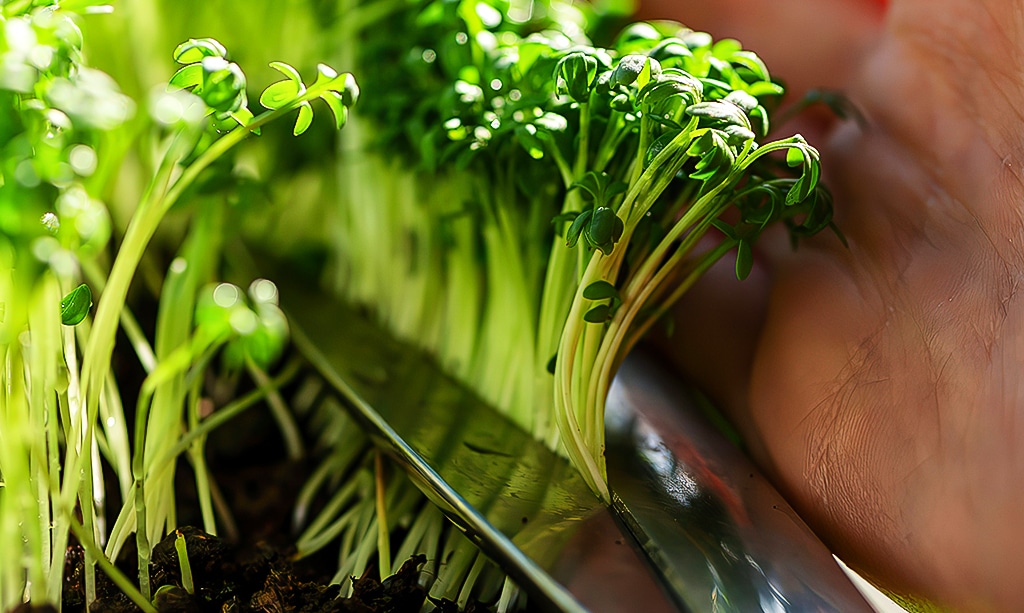
Sprouts, on the other hand, are often grown in water without soil and can be ready to harvest within 3-5 days of germination.
Unlike microgreens, sprouts are consumed whole, including the germinated seeds, roots, stems, and underdeveloped leaves.
It’s important to rinse them thoroughly in clean water before consuming or storing them to remove any potential hulls retained from germination.
The timing of harvest is crucial for both microgreens and sprouts. If harvested too early, they can have weaker flavors and fewer nutrients, while waiting too long can lead to tougher textures and less appealing tastes.
It’s also important to note that both should be harvested just before consuming for optimal freshness as their nutrient content begins to degrade once they’re cut or rinsed.
Harvesting should ideally take place in cool conditions, such as early morning or late evening, when heat stress on the plants is at its minimum.
It’s also important to avoid any unnecessary contact with water until just before use, as post-harvest treatment significantly impacts shelf life.
Storing Microgreens and Sprouts
When it comes to storing microgreens and sprouts, it’s important to keep in mind their living nature and delicate structure.
Proper storage can help preserve their freshness and nutritional value.
The key is to maintain a balance between humidity and airflow to prevent decomposition and mold growth.
After harvesting microgreens, store them in a breathable container, like a paper towel-lined salad box or a plastic container with small ventilation holes, in the refrigerator at a temperature between 39-41 Fahrenheit (4-5 degrees Celsius).
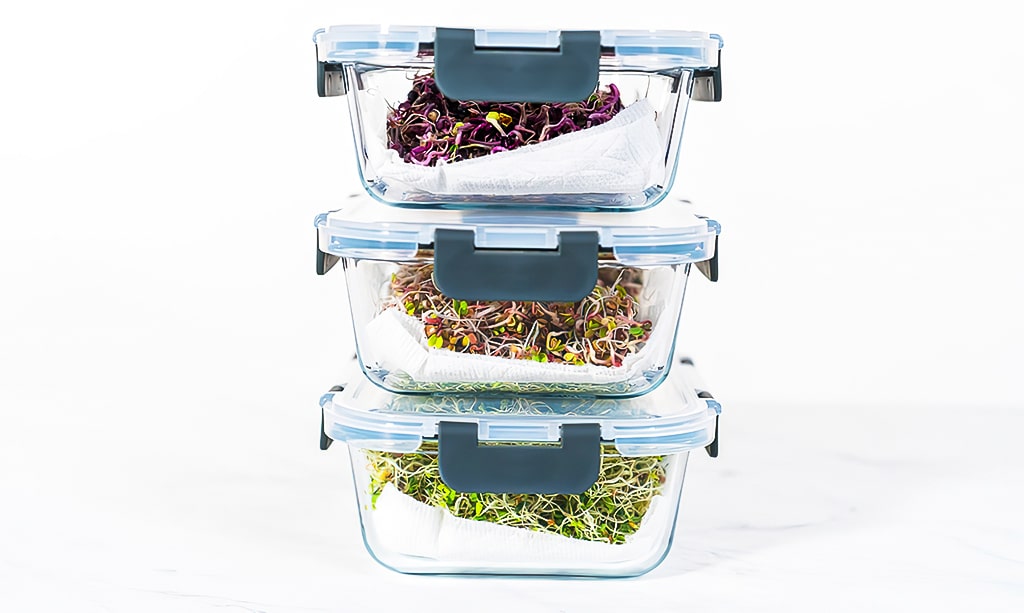
Sprouts have a longer shelf life due to their matured plant structure. After harvesting, remove any hulls or seed coats that could spoil over time.
Store sprouts in breathable containers that allow minimal moisture retention and sufficient humidity.
To ensure maximum freshness, avoid overcrowding containers and regularly inspect stored greens for decay.
Following these storage and handling practices, you can enjoy fresh and nutritious greens every time.
Safety and Sanitation
When it comes to safety and cleanliness, it’s crucial to handle microgreens and sprouts with care.
Protecting the health of consumers should be a top priority, which means following proper hygiene practices during cultivation, harvesting, storage, and consumption.
These plant foods are typically eaten raw, so it’s essential to prioritize food safety.
Before planting, the seeds should be sterilized to eliminate any potential pathogens.
Sprouting requires a warm and humid environment, which can encourage the growth of harmful bacteria like E. Coli or Salmonella.
However, rigorous sanitation measures can significantly reduce this risk.
The growing medium should also be clean and free from contaminants that could compromise the safety or quality of the crops.
During harvest, tools must be sanitized, and the greens should be handled with care to prevent damage or bruising that could make them vulnerable to bacterial invasion.
After harvesting, it’s best to refrigerate microgreens and sprouts immediately at temperatures below 40 degrees Fahrenheit (4 degrees Celsius) to suppress bacterial growth and keep them fresh for longer.
When consuming these delicate and nutritious foods, it’s essential to practice good personal hygiene, such as washing hands thoroughly to avoid cross-contamination.
By following these measures and maintaining high standards of cleanliness, we can enjoy the full benefits of microgreens and sprouts safely.
Gardening and Sustainability
The world of microgreens and sprouts offers more than just nutrition. It plays a significant role in sustainability and environmentally conscious gardening practices.
Growing your microgreens and sprouts at home is a form of urban agriculture that promotes self-sufficiency and reduces the environmental impact of transporting produce over long distances.
They require minimal space, making them perfect for city dwellers.
With a quick growth rate, most varieties are ready for harvest within one to three weeks, ensuring a constant supply of fresh greens without the need for vast plots of land or sophisticated gardening tools.
Cultivating microgreens and sprouts contributes significantly to resource conservation by reducing water usage and eliminating the need for synthetic fertilizers and harmful pesticides.
Sprouts have zero waste potential as every part of the plant is edible, eliminating food wastage.
The spent growing mediums such as soil can be composted and reintegrated back into the garden, creating a circular economy model where waste is continuously redirected back into the system.
Microgreens and sprouts can also help tackle food security issues by providing nutrient-dense foods in areas with limited access to fresh produce.
Education programs can encourage communities to grow their microgreens and sprouts, promoting sustainable farming practices and alleviating malnutrition-related problems.
These plants represent a resilient form of agriculture that aligns harmoniously with sustainable living principles.
They embody a compelling synergy between healthful eating habits and eco-conscious lifestyle choices, making them an appealing choice for anyone wishing to enhance personal wellness while making positive contributions towards global environmental goals.
Popularity and Trends
The use of microgreens and sprouts in gastronomy has significantly increased in recent times.
They are no longer just used as garnishes but are now primary ingredients in dishes.
This shift can be attributed to the growing awareness of consumers towards nutrition and sustainability.
Microgreens and sprouts are contributing significantly to the popularity of plant-based diets in high-end restaurants and home kitchens.
They are also becoming popular in health and wellness circles due to their nutritional value and detoxifying properties.
Their increasing visibility on social media platforms has made them popular among millennials.
Cultivation of these greens has increased significantly in commercial farms and urban home gardens, with microgreen farming becoming popular due to its low space requirement, quick turnaround time, and perceived ecological benefits.
Meal delivery services have also incorporated microgreens into meal plans designed for health-conscious consumers who prioritize macronutrient quality over quantity.
Educational workshops teaching methods of cultivation at home are also becoming popular as part of sustainable living initiatives.
However, as with any trend, be aware of potential pitfalls, such as contamination issues during cultivation or misleading nutritional claims. Critical evaluation is vital before embracing any trend.
Conclusion
When it comes to achieving optimal health, microgreens and sprouts are not rivals but rather valuable allies.
They each offer unique qualities that contribute significantly to a nutritious diet.
Despite their small size, microgreens pack a powerful punch of nutrients and can elevate any meal with their vibrant hues and intricate flavors.
Sprouts, on the other hand, are versatile across cuisines worldwide and offer a satisfying crunch that adds a delightful dimension to meals.
What’s more, cultivating these plants can be an enriching experience, even for those with no prior gardening experience.
The low space requirement and swift harvesting cycles make them ideal candidates for urban farming or indoor gardening setups, aiding sustainability efforts on our planet.
As more people lean towards healthier lifestyles and mindful eating habits, microgreens and sprouts are expected to gain even more popularity in kitchens around the world.
Whether you choose microgreens, sprouts, or both, you’ll be choosing nourishment for your body and palate while supporting sustainability efforts.
It’s a win-win situation that allows vibrant health to burst from little packages of green delight!



Comments (4)
I am glad I found this article!!! It is very thorough and perfect for anyone new to microgreens or sprouts.
I’ve been growing microgreens for awhile and about to begin growing sprouts for the first time. You answered a question that I was having difficulty finding the answer on the web.
Thank you for taking the time to put together this article.
Hi Darin, thank you for your kind words! I’m thrilled to hear that you found the article helpful and thorough, especially as someone who’s already experienced in growing microgreens. It’s fantastic that I could assist with your question about sprouts. If you have any more questions or need further guidance feel free to reach out. Happy growing, and best of luck with your new sprouting endeavors!
This is the absolutely finest most comprehensive article I’ve read explaining these two food sources. Thank you!!
Joan, thank you so much for your kind words! I’m thrilled to hear that our article on Microgreens vs Sprouts was informative. It’s fantastic to know that the information provided helped you better understand the difference between microgreens and sprouts. If you have any further questions or if there’s anything else you’d like to learn about microgreens, please feel free to reach out. Your feedback is greatly appreciated!